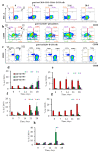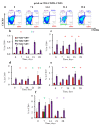Early IgE Production Is Linked with Extrafollicular B- and T-Cell Activation in Low-Dose Allergy Model
- PMID: 35746576
- PMCID: PMC9231339
- DOI: 10.3390/vaccines10060969
Early IgE Production Is Linked with Extrafollicular B- and T-Cell Activation in Low-Dose Allergy Model
Abstract
Despite its paramount importance, the predominant association of early IgE production with harmless antigens, via germinal-center B- and T-cell subpopulations or extrafollicular activation, remains unresolved. The aim of this work was to clarify whether the reinforced IgE production following the subcutaneous immunization of BALB/c mice with low antigen doses in withers adipose tissue might be linked with intensified extrafollicular or germinal-center responses. The mice were immunized three times a week for 4 weeks in the withers region, which is enriched in subcutaneous fat and tissue-associated B cells, with high and low OVA doses and via the intraperitoneal route for comparison. During long-term immunization with both low and high antigen doses in the withers region, but not via the intraperitoneal route, we observed a significant accumulation of B220-CD1d-CD5-CD19+ B-2 extrafollicular plasmablasts in the subcutaneous fat and regional lymph nodes but not in the intraperitoneal fat. Only low antigen doses induced a significant accumulation of CXCR4+ CXCR5- CD4+ extrafollicular T helpers in the withers adipose tissue but not in the regional lymph nodes or abdominal fat. Only in subcutaneous fat was there a combination of extrafollicular helper accumulation. In conclusion, extrafollicular B- and T-cell activation are necessary for early IgE class switching.
Keywords: IgE; extrafollicular T helpers; extrafollicular response; plasmablasts; subcutaneous fat.
Conflict of interest statement
The authors declare no conflict of interest.
Figures






Similar articles
-
Tertiary lymphoid structure related B-cell IgE isotype switching and secondary lymphoid organ linked IgE production in mouse allergy model.BMC Immunol. 2020 Aug 7;21(1):45. doi: 10.1186/s12865-020-00376-7. BMC Immunol. 2020. PMID: 32767965 Free PMC article.
-
Single and coexpression of CXCR4 and CXCR5 identifies CD4 T helper cells in distinct lymph node niches during influenza virus infection.J Virol. 2012 Jul;86(13):7146-57. doi: 10.1128/JVI.06904-11. Epub 2012 Apr 24. J Virol. 2012. PMID: 22532671 Free PMC article.
-
Loss of CD154 impairs the Th2 extrafollicular plasma cell response but not early T cell proliferation and interleukin-4 induction.Immunology. 2004 Oct;113(2):187-93. doi: 10.1111/j.1365-2567.2004.01951.x. Immunology. 2004. PMID: 15379979 Free PMC article.
-
Extrafollicular antibody responses.Immunol Rev. 2003 Aug;194:8-18. doi: 10.1034/j.1600-065x.2003.00058.x. Immunol Rev. 2003. PMID: 12846803 Review.
-
Surface-linked liposomal antigen induces IgE selective unresponsiveness in a T-cell independent fashion.Curr Drug Targets Immune Endocr Metabol Disord. 2003 Jun;3(2):119-35. doi: 10.2174/1568008033340252. Curr Drug Targets Immune Endocr Metabol Disord. 2003. PMID: 12769784 Review.
Cited by
-
DEPs Induce Local Ige Class Switching Independent of Their Ability to Stimulate iBALT de Novo Formation.Int J Environ Res Public Health. 2022 Oct 11;19(20):13063. doi: 10.3390/ijerph192013063. Int J Environ Res Public Health. 2022. PMID: 36293642 Free PMC article.
References
-
- Sweerus K., Lachowicz-Scroggins M., Gordon E., LaFemina M., Huang X., Parikh M., Kanegai C., Fahy J.V., Frank J.A. Claudin-18 deficiency is associated with airway epithelial barrier dysfunction and asthma. J. Allergy Clin. Immunol. 2017;139:72–81. doi: 10.1016/j.jaci.2016.02.035. - DOI - PMC - PubMed
Grants and funding
LinkOut - more resources
Full Text Sources
Research Materials

